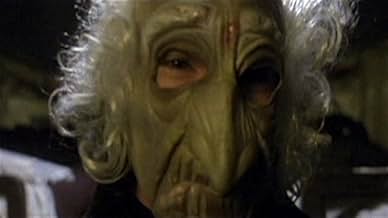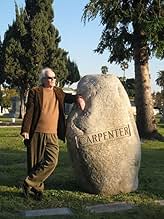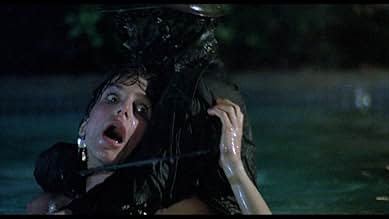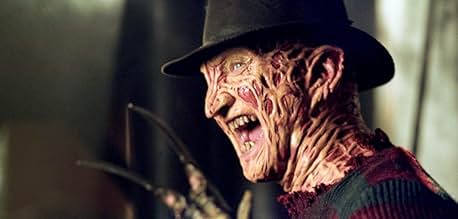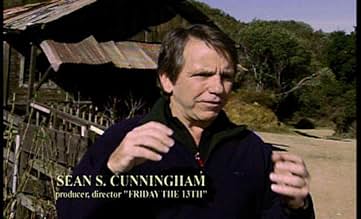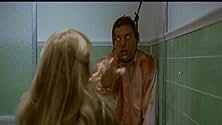IMDb RATING
7.2/10
3.7K
YOUR RATING
A documentary on the history of the slasher film.A documentary on the history of the slasher film.A documentary on the history of the slasher film.
Amy Holden Jones
- Self
- (as Amy Holden-Jones)
Anthony Timpone
- Self
- (as Tony Timpone)
Featured reviews
I'm a little impressed. Whether the credit belongs to director Jeff McQueen, producers Rachel Belofsky and Rudy Scalese, or the writers, this is a more meaningful, thoughtful documentary than I supposed it was going to be. I'm not saying that it's perfect, because there are embellishments here and there (music cues, title cards) that are a bit gauche, and the enthusiasm and anecdotes that some interviewees share are a bit much at times. Then again, that enthusiasm really speaks to how much fun everyone had making these movies, the passion they have for the underlying craft, and the thrill of the visceral storytelling. The feature earnestly covers a lot of ground: the violent thrillers from which slashers took influence; the art of illusion behind practical effects like blood and gore; discussion of where slashers fit into society and culture, and how they may or may not reflect that society and culture; the push to make movies that exploited every possible holiday and occasion, and every possible weapon of choice; and more. From producers and directors to effects artists and stars, we're greeted with a slew of interview subjects who offer their own perspective on the genre, with focus primarily on the golden age of the slasher from their inauguration with John Carpenter's 'Halloween' in 1978, to the early and mid 80s when slashers had more or less become the new "it" girl of horror. There is nothing in 'Going to pieces' that's a particular revelation, yet the picture gives welcome, broad perspective - or rather, retrospective - that's more sincere and ruminative than I'd have guessed before I sat to watch.
Some films get more emphasis than others, and not unreasonably; 'Halloween' began it all, 'Friday the 13th' raised the bar with crimson and viscera, and 'A nightmare on Elm Street' took things in a wild new direction. If only in passing, though, this touches upon even more flicks than I've seen, and some I'd never even heard of. Along the way, there's an early spotlight on the conventions that largely define slashers, including settings, protagonists, antagonists, murder weapons, and more - and with this in mind, one place where I think the title falters is in failing to identify how easily the genre became very formulaic, and very stale, very quickly. True, there are still many viewers who flock to slashers for the cavalcade of random violence and death, but I think there came a point where slashers became dull unless there is either some major point of brilliance to help it stand out, or some new twist on the style (e.g., 2015's 'The final girls') that really upended norms. In some measure 'The rise and fall of the slasher film' also raises reasonable questions: of what specifically defines the "slasher"; if every piece mentioned herein really is a slasher or just falls into "horror" generally, or some other subgenre; the extent to which slashers may have had influence elsewhere in horror; and ultimately how accurate the name even is, if slashers continue to be a major force in horror cinema. The documentary really does cover a lot of ground, but it could have broadened its scope even more, and despite the name it's worth observing that there's not so much a central thesis here as an overarching idea of examining the genre.
There are notions touched upon in passing that could have been explored even more deeply: the regressive, conservative values that seemingly inform killers in movies; the triumph of "the final girl" as a representation of feminism; the outdated, harmful language and ideas that "other" and demonize a subset of the population by setting up a particular type of figure as the killer (i.e., lots of ableism, homophobia, and transphobia); and so on. In fairness, to whatever extent 'Going to pieces' could have done more, maybe these were also beyond its purview, for the chief intent here was in a sort of history of the genre (as of 2006), and if imperfectly, I think it does that job very well. Whether one is a fan of slashers, or of documentaries, or just an avid cinephile at large, I think there's much to appreciate here for a lot of folks. All told it may not be something one needs to go out of their way to see, but for something light yet interesting, 'Going to pieces' is a fine movie that's well worth checking out if you have the chance.
Some films get more emphasis than others, and not unreasonably; 'Halloween' began it all, 'Friday the 13th' raised the bar with crimson and viscera, and 'A nightmare on Elm Street' took things in a wild new direction. If only in passing, though, this touches upon even more flicks than I've seen, and some I'd never even heard of. Along the way, there's an early spotlight on the conventions that largely define slashers, including settings, protagonists, antagonists, murder weapons, and more - and with this in mind, one place where I think the title falters is in failing to identify how easily the genre became very formulaic, and very stale, very quickly. True, there are still many viewers who flock to slashers for the cavalcade of random violence and death, but I think there came a point where slashers became dull unless there is either some major point of brilliance to help it stand out, or some new twist on the style (e.g., 2015's 'The final girls') that really upended norms. In some measure 'The rise and fall of the slasher film' also raises reasonable questions: of what specifically defines the "slasher"; if every piece mentioned herein really is a slasher or just falls into "horror" generally, or some other subgenre; the extent to which slashers may have had influence elsewhere in horror; and ultimately how accurate the name even is, if slashers continue to be a major force in horror cinema. The documentary really does cover a lot of ground, but it could have broadened its scope even more, and despite the name it's worth observing that there's not so much a central thesis here as an overarching idea of examining the genre.
There are notions touched upon in passing that could have been explored even more deeply: the regressive, conservative values that seemingly inform killers in movies; the triumph of "the final girl" as a representation of feminism; the outdated, harmful language and ideas that "other" and demonize a subset of the population by setting up a particular type of figure as the killer (i.e., lots of ableism, homophobia, and transphobia); and so on. In fairness, to whatever extent 'Going to pieces' could have done more, maybe these were also beyond its purview, for the chief intent here was in a sort of history of the genre (as of 2006), and if imperfectly, I think it does that job very well. Whether one is a fan of slashers, or of documentaries, or just an avid cinephile at large, I think there's much to appreciate here for a lot of folks. All told it may not be something one needs to go out of their way to see, but for something light yet interesting, 'Going to pieces' is a fine movie that's well worth checking out if you have the chance.
I was raised on Dracula and Frankenstein, and was living in Europe during the rise and fall of the slasher film. I have not seen most of the films mentioned in this film.
However, I was pleased at the presentation and now have a sense of history as to how the slashers came into being, the influences of Italian directors like Bava and Argento, the importance of the makeup and special effects guys, and the guttural significance of slasher films.
It was extremely interesting to see the directors and producers and actors and how they felt about the work they had done and were doing. I was also excited to see people like George Clooney, Jamie Lee Curtis, Cary Elwes, Robert Englund, Sid Haig, Heather Langenkamp, Dina Meyer, Bill Moseley, and many more in clips from their performances.
Of course, I am always happy to see Christa Campbell.
However, I was pleased at the presentation and now have a sense of history as to how the slashers came into being, the influences of Italian directors like Bava and Argento, the importance of the makeup and special effects guys, and the guttural significance of slasher films.
It was extremely interesting to see the directors and producers and actors and how they felt about the work they had done and were doing. I was also excited to see people like George Clooney, Jamie Lee Curtis, Cary Elwes, Robert Englund, Sid Haig, Heather Langenkamp, Dina Meyer, Bill Moseley, and many more in clips from their performances.
Of course, I am always happy to see Christa Campbell.
This is an interesting and pretty thorough documentary on the slasher film. It's not as good as reading a book on the subject, of course (there are several now, and this documentary is based on one of the better ones), but you get lots of films clips, and some interviews, not only with the usual horror convention attendees like Tom Savini and Felissa Rose,but also with more obscure characters like the Rabbi Herbert Freed who directed the obscure slasher "Graduation Day" (before he was a rabbi, of course).
What's most interesting for someone like me who is old enough to remember the first wave of slasher movies, is to recall how alarmed adults were at the time by these movies, which look like pretty harmless fun now. I especially remember the way they actually picketed "Silent Night, Deadly Night" because they were upset by the idea of an axe-murdering Santa Claus (in an ideal world these kind of idiots would be met with tear gas and police batons, just like anti-war protesters--who often have a legitimate reason for being upset--often are).
It's also ironic how widely available, thanks to DVD, uncut versions of these movies are today, considering how they were hacked up by American censors back then or outright banned over in Britain. It's probably just as stupid to get worked up about movies like "Hostel" or "Captivity" like people do nowadays. Remember the famous ad-line to "Last House on the Left" (one movie this doc barely mentions, although I guess it isn't really a slasher). "It's only a movie... It's only a movie. . .
What's most interesting for someone like me who is old enough to remember the first wave of slasher movies, is to recall how alarmed adults were at the time by these movies, which look like pretty harmless fun now. I especially remember the way they actually picketed "Silent Night, Deadly Night" because they were upset by the idea of an axe-murdering Santa Claus (in an ideal world these kind of idiots would be met with tear gas and police batons, just like anti-war protesters--who often have a legitimate reason for being upset--often are).
It's also ironic how widely available, thanks to DVD, uncut versions of these movies are today, considering how they were hacked up by American censors back then or outright banned over in Britain. It's probably just as stupid to get worked up about movies like "Hostel" or "Captivity" like people do nowadays. Remember the famous ad-line to "Last House on the Left" (one movie this doc barely mentions, although I guess it isn't really a slasher). "It's only a movie... It's only a movie. . .
This is pretty much what you'd expect from the title: a group of actors, directors and special effects people talk about the slasher genre of the early 1980s. They cover all the big ones, some of the lesser ones, and go over the backgrounds.
How did the Italian films of Mario Bava influence the slashers? Are they anti-woman? Do they make kids do bad things? Is it a dead genre? All of this is covered and more... such as the concept of the "final girl" and other tropes so often found in horror.
I would have liked a bit more history, and maybe more credit given to Bob Clark and "Black Christmas" (which, to me, deserves more recognition than John Carpenter's "Halloween"). But I can't really complain with all these people they found to interview -- getting Carpenter, Craven, Rob Zombie and more to appear on film? Well done.
I have met the man who wrote the book this film is based on, the charming Adam Rockoff. If this film was your idea of education, get his book! Much more than you can cram into a 90-minute film.
How did the Italian films of Mario Bava influence the slashers? Are they anti-woman? Do they make kids do bad things? Is it a dead genre? All of this is covered and more... such as the concept of the "final girl" and other tropes so often found in horror.
I would have liked a bit more history, and maybe more credit given to Bob Clark and "Black Christmas" (which, to me, deserves more recognition than John Carpenter's "Halloween"). But I can't really complain with all these people they found to interview -- getting Carpenter, Craven, Rob Zombie and more to appear on film? Well done.
I have met the man who wrote the book this film is based on, the charming Adam Rockoff. If this film was your idea of education, get his book! Much more than you can cram into a 90-minute film.
The positive things about "Going To Pieces" are that it tries hard to include as many Slasher flicks as possible and deliver pieces of trivia for each of them. There are interviews with some influential directors of the genre (John Carpenter, Wes Craven, Sean Cunningham,...), actors, make-up guru Tom Savini and some "horror-experts".
For starters, this movie is a good introduction to the genre. Real fans will not find a lot of new information here. We all know about the influence of "Halloween", we've heard the story of how Freddy Krueger has been created, we know how Wes Craven revived the genre with "Scream". Sure, it's unfair to criticize that all this is being told again in a documentary like this. After all the story wouldn't be complete without this information, but in the end one can't learn too much from "Going To Pieces".
It would have been a real treat to learn the history of gore in movies, to learn about the influences for American slasher in detail. Instead we are only told about Italian horror in what seems like 2 minutes and then there's no further mention of it. "Halloween" is made out to be the first slasher movie, when even "Black Christmas" came before it in America. "Friday The 13th" is given more credit than it really deserves as an original movie. Make no mistake, I'm not trying to imply that those movies aren't very important to the genre, but it would have been a fresh approach to take a closer look at their origins.
Another thing to consider is that before "Going To Pieces" you should either make sure that you know all of the movies mentioned in the documentary or accept the fact that some great twist endings will be spoiled for you, some of which are the only reason to watch these flicks in the first place ("Sleepaway Camp", "Happy Birthday To Me").
In the end "Going To Pieces" will get you excited about watching old slasher flicks again (probably until you rent something like "Pieces" and realize the film is not half as exciting as it's made out to be in hindsight), but there are books out there that are a lot more informative than this documentary.
For starters, this movie is a good introduction to the genre. Real fans will not find a lot of new information here. We all know about the influence of "Halloween", we've heard the story of how Freddy Krueger has been created, we know how Wes Craven revived the genre with "Scream". Sure, it's unfair to criticize that all this is being told again in a documentary like this. After all the story wouldn't be complete without this information, but in the end one can't learn too much from "Going To Pieces".
It would have been a real treat to learn the history of gore in movies, to learn about the influences for American slasher in detail. Instead we are only told about Italian horror in what seems like 2 minutes and then there's no further mention of it. "Halloween" is made out to be the first slasher movie, when even "Black Christmas" came before it in America. "Friday The 13th" is given more credit than it really deserves as an original movie. Make no mistake, I'm not trying to imply that those movies aren't very important to the genre, but it would have been a fresh approach to take a closer look at their origins.
Another thing to consider is that before "Going To Pieces" you should either make sure that you know all of the movies mentioned in the documentary or accept the fact that some great twist endings will be spoiled for you, some of which are the only reason to watch these flicks in the first place ("Sleepaway Camp", "Happy Birthday To Me").
In the end "Going To Pieces" will get you excited about watching old slasher flicks again (probably until you rent something like "Pieces" and realize the film is not half as exciting as it's made out to be in hindsight), but there are books out there that are a lot more informative than this documentary.
Did you know
- TriviaExecutive Producer Michael Ruggerio had previously worked on The American Nightmare (2000), one of the documentaries that inspired Going To Pieces. He always said he wanted to do a sequel about the Slasher movies of the 1980's. He happened to be good friends with author Adam Rockoff. After producer Rudy Scalese optioned the book rights to Going to Pieces and befriended Adam Rockoff, Adam made an introduction to Ruggerio who was now an executive at STARZ and championed the documentary to be made.
- Quotes
John Carpenter: New talents come along, old talents fade away.
- ConnectionsFeatures La Guerre des mondes (1953)
Details
- Release date
- Country of origin
- Language
- Also known as
- Going to Pieces - el éxito y la caída del cine de destazamiento
- Filming locations
- Los Angeles, California, USA(Hollywood Forever Cemetary)
- Production companies
- See more company credits at IMDbPro
Box office
- Budget
- $600,000 (estimated)
Contribute to this page
Suggest an edit or add missing content



